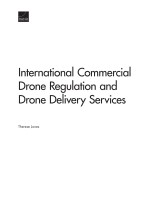| 来源类型 | Research Reports
|
| 规范类型 | 报告
|
| DOI | https://doi.org/10.7249/RR1718.3
|
| 来源ID | RR-1718/3-RC
|
| International Commercial Drone Regulation and Drone Delivery Services |
| Therese Jones
|
| 发表日期 | 2017
|
| 出版年 | 2017
|
| 页码 | 47
|
| 语种 | 英语
|
| 结论 |
Approaches to Regulation Differ Across the Globe- Approaches to regulation differ dramatically across the globe, but the elements of regulation are largely the same from country to country, with wide ranges on the level of restrictiveness of each element that are often dictated by whether a country favors the promotion of new technology or a safety-first approach. The standard example of national drone regulation tends to have a pilot's license, aircraft registration, restricted zones, and insurance. The requirements of these four elements vary based on drone mass, drone altitude, drone use, and pilot license level.
Drone Regulation Strategies Vary by Country- The regulatory methodologies for incorporating drones into legal systems range from outright bans on the use of commercial drones, to permissive legislation, to a strategy of waiting to observe the efficacy of other nations' policies before acting.
Obstacles to Delivery Drone Use Remain Widespread- The primary obstacle to using delivery drones in most nations is a requirement that drones stay within the pilot's visual line of sight. Some countries, such as Japan, are experimenting with delivery beyond visual line of sight in restricted areas, with the hope of expanding the program countrywide once effective regulations become apparent.
|
| 摘要 |
- Even for countries with existing drone legislation, laws are constantly being reevaluated. While drone laws almost always move toward a more permissive approach to regulation, critical infrastructure improvements may aid in the success of such a transition.
- Specialized training courses, pilot exams based on the type of UAV and the conditions under which UAVs operate, and liability insurance to protect against mishaps over populated areas are all mechanisms for ensuring the safety of the general population as usage laws become more permissive.
- Monitoring the evolution of international drone regulations, along with technology trends and security and safety incidents in the studied countries over the next several years will provide insight into how gradual or all-or-nothing approaches to regulation impact technology adoption, and whether or not gradual approaches to introducing untested technology mitigate potential hazards.
|
| 主题 | Civilian and Commercial Drones
; Science and Technology Legislation
; Science
; Technology
; and Innovation Policy
|
| URL | https://www.rand.org/pubs/research_reports/RR1718z3.html
|
| 来源智库 | RAND Corporation (United States)
|
| 引用统计 |
|
| 资源类型 | 智库出版物
|
| 条目标识符 | http://119.78.100.153/handle/2XGU8XDN/108674
|
推荐引用方式
GB/T 7714 |
Therese Jones. International Commercial Drone Regulation and Drone Delivery Services. 2017.
|
|
文件名:
|
x1540240024770.jpg
|
|
格式:
|
JPEG
|

|
文件名:
|
RAND_RR1718z3.pdf
|
|
格式:
|
Adobe PDF
|
除非特别说明,本系统中所有内容都受版权保护,并保留所有权利。